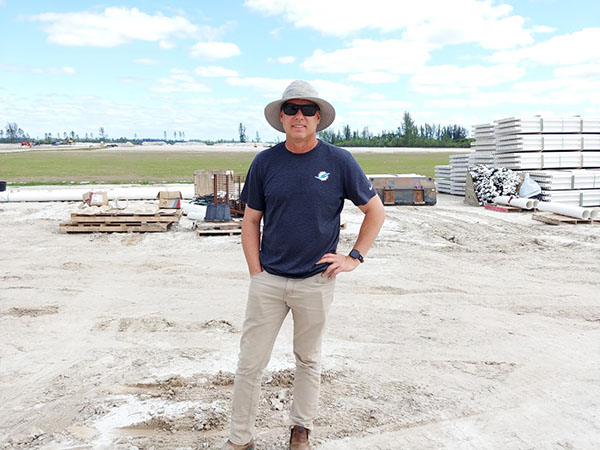Loxahatchee Groves has a new neighbor, on an 80-acre site, growing sod for the Miami Dolphins and Hard Rock Stadium in Miami Gardens.
Matt Tacilauskas manages the facility, located north of North Road between B and C roads. He said that the first planting of sod is now growing.
“That’s the first field we planted,” Tacilauskas said. “We’re hoping it will be ready for use during the football season this fall.”
Tacilauskas was a golf course superintendent for 20 years, most recently at the Palm Beach Country Club, before he started working for the Dolphins, first as a consultant and then taking over the sod operation.
The Dolphins organization bought the site last year and has been busy preparing the land and transplanting more than 1,000 native sabal palms that were on the site to the front to act as a buffer.
The Dolphins previously were using independent contractors in Alabama, Georgia and North Carolina to haul in sod. The franchise saw the opportunity to source the sod locally, keeping the business in Florida and cutting down on the environmental footprint to transport it.
The site includes 100 percent water retention to ponds located on site. “We’re injecting a lot of their ways into this place in regard to how it’s set up environmentally,” Tacilauskas said. “One-hundred percent of this property is self-contained. Right up to the perimeter, all the water comes back to these ponds.”
The site includes a maintenance facility with washdown pads so that dirt and grass clippings go back on-site, and 22 plots that will eventually be football-field-sized lush Bermudagrass for harvesting.
“It’s mostly Bermuda,” he said. “Basically, whatever the client wants, we’ll give them.”
The client list is still being confirmed, but the aim of the project is to be a source not only for South Florida professional and collegiate sports teams, but sports entities throughout the southeast.
The 22 carefully laid-out fields will all have popup sprinklers. Each field is laid out with a 1 percent slope to catch any runoff during storm events to carry it back to the retention ponds.
“It’s all grown on plastic, which is the big difference between us and other sod farms,” Tacilauskas said. “We put down the plastic and a little netting on top, and then a little grass on top, and then we top dress to get it to an inch and a half, and then we roll it up like a piece of carpet to deliver it.”
The fields are started with sprigs a few inches apart rather than seeds for maximum productivity.
“We can also lay sod on there, too, and just grow it up,” Tacilauskas said. “Every time we pull a field up, we go through the same process again — level it, plastic down, grass and build it back up again. You could probably get two fields a year out of one plot because of the growing possibilities in Florida.”
Tacilauskas pointed out bee hives set around the perimeter, which will eventually have flower bushes planted on the borders.
The plots use a sand mix that is ideal for drainage.
“When we top dress, we use a sand that comes out of central Florida that has the right size particles to USDA standards,” he said. “We have to apply sand that we know is going to drain. We’re looking for about 20 inches an hour. You have to use straight sand. If you start using organic matter, it slows up the [percolation] rate. We have to make sure that if we get a gully washer in the middle of a football game, that it will drain.”
All the plots at the site are carefully planned at the 1 percent grade so that all excess water drains back into the retention ponds for reuse, using 2,400-gallon-per-minute pumps with a wet well that goes down 20 feet to draw the water, giving the farm the capability to water about six fields simultaneously. “The huge advantage of the plastic sheets is very minimal water use,” Tacilauskas said. “It just doesn’t go anywhere… Everybody is worried about the water use, but we’re probably 10 percent water use of a regular sod farm.”
Tacilauskas said that after they get fully set up, he wants to have field days at the site to hold promotional activities. “We’ll set up a tent and explain how we operate and what we’re doing,” he said. “We’re certainly about doing it right, that’s for sure.”
Of the 80-acre site, there is 52 acres of turf,” he said, about 35 or 40 football field equivalencies.
The two ponds are about 14 feet deep, with littoral edges where aquatic plants are being planted and will eventually be stocked by the U.S. Fish & Wildlife Service.
“Country Club Services is doing all the dirt work out here,” Tacilauskas said. “They’re a local company that has been here about 20 years. Roy Briggs, who did the irrigation work, he’s a local company. We try to keep it all close.”
By moving the farm closer to the stadium, he figures the organization will save considerably in shipping costs, especially since they change the sod six to seven times each season.








